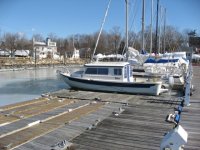If you google vinylester blisters you can come up with lots of info. For example see:
http://www.zahnisers.com/repair/blister/blister1.htm
The following is from a paper posted at the above link and explains the situation of epoxy and vinylester. If you have the time or inclination click on the link and read the whole paper, it is quite good in my opinion in expaining the cause and how the blister problem has beed addressed.
"THE BARRIER COAT:
Following removal of hydrolyzed material, drying and replacement of glass as necessary, a barrier coat is applied. Until 1988, epoxies were generally used for this because of their high physical strength and waterproof qualities. In practical use, however, epoxies were less than ideal. Their application is difficult, requiring exact measuring and mixing habits, warm temperatures and dry atmosphere to achieve claimed physical properties. In the field, it has been noted that epoxies are only marginally tolerant of polyester substrates and seem to reject acidic laminates over time. The results are often blistered barrier coats and reduced protection and durability.
Vinylester resins have increasingly become the standard barrier coat used for blister repair, in the mid-Atlantic region at least. Designed for high corrosion resistance and high physical strength, they combine the good water proof lab specs of epoxy with the ease of application of a polyester resin. The theoretical "waterproofness" for equal skin thickness is marginally less than epoxy but because of it's flexibility and lower cost, vinylester resin can be applied in thicker skins, greatly increasing waterproofness. Thickness is an important factor in a barrier coat. Vinylester is much more compatible with the polyester than epoxies. The bonding strength of vinylesters to the original polyester is better than either polyesters or epoxies. We have used vinylester for barrier coasts exclusively now for over seven years.
As a barrier coat, we apply six rolled coats to arrive at a thickness of .030". This is two - three times the thickness of most epoxy systems. On top of the barrier coat, a vinylester sanding primer is applied and largely sanded off to smooth the bottom. By using the gelkote and laminate removing tool initially and careful filling and sanding, the bottom fairness is quite good and meets most owner's requirements. If race quality finish is required, this is accomplished by many hours of hand fairing.
Once fair, two coats of antifouling completes the repair. The boat is cleaned and launched. "
My 2004 CD25 was not special order, it was, I believe the norm for 2004 CD25. During 2004 the CD25 was being built in the new factory and the CD22 in the old original facility. During a phone call my questions regarding the layup led me to the plant manager at the CD25 facility who told me the 25's were being build entirely with vinylester and the CD22's with polyester. He told me he should know because he was in charge and the drums in front of him were vinylester. I would think that as the construction methods were updated and refined and as the cost of resin increased with the price of oil in the last few years that the resin used in current hulls may not be the same as before. I don't know what they are using now.
At the time I had my dealer in Florida apply the bottom paint, I was also told that epoxy barrier coat would be redundant and not neccessary.
I feel fortunate that my boat is all vinylester and have no qualms about leaving it in the drink all year round. If anyone does barrier coat or apply bottom paint, I would suggest that they do not sand or pressure wash the gelcoat which would likely increase the water permeability of the hull and lead to more rapid hydrolysis.

